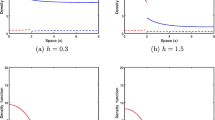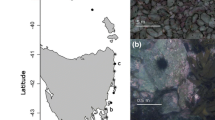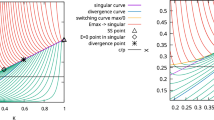Abstract
Economists have relied on convexity assumptions for a long time but many natural resources that stem from ecosystems have non-convexities in their dynamics. This article illustrates the consequences of relaxing convexity assumptions for management and the role of fast and slow variables. The paper presents a general framework to handle systems with fast and slow variables, and illustrates the method using a model of coral reefs subject to fishing pressure. The insights obtained are used to discuss alternative management strategies.
Similar content being viewed by others
References
Arrow K. J., Fisher A. C. (1974) Environmental Preservation Uncertainty, and Irreversibility. Quarterly Journal of Economics 88:312–319
Brock W. A., Starrett D. (2003) Managing Systems with Non-convex Positive Feedback. Environmental and Resource Economics 26(4):575–602
Carpenter S. R. (2003) Regime Shifts in Lake Ecosystems: Pattern and Variation, Vol 15, Excellence in Ecology Series. Ecology Institute, Oldendorf/Luhe, Germany
Carpenter S. R., Brock W. A. (2004) Spatial Complexity, Resilience, and Policy Diversity: Fishing on Lake-rich Landscapes. Ecology and Society 9(1):1–31
Carpenter S. R., Turner M. G. (2000a) Special Issue on Interactions of Fast and Slow Variables in Ecosystems. Ecosystems 3(6):495–595. Special issue
Carpenter S. R., Turner M. G. (2001) Hares and Tortoises: Interactions of Fast and Slow Variables in Ecosystems. Ecosystems 3(6):495–497
Clark, C. W. (1990), Mathematical Bioeconomics – The Optimal Management of Renewable Resources, in: Pure and Applied Mathematics, 2nd edition. Wiley. First published in 1976.
Claussen M., Kubatzki C., Brovkin V., Ganopolski A., Hoelzmann P., Pachur H. (1999) Simulation of an Abrupt Change in Saharan Vegetation at the End of Mid-Holocene. Geophysical Research Letters 26(14):2037–2040
Crépin, A.-S. (2002), Tackling the Economics of Ecosystems, PhD Thesis, Stockholm University, Department of Economics. Dissertations in Economics 2002, 6.
Crépin A.-S. (2003) Multiple Species Boreal Forests – What Faustmann Missed. Environmental and Resource Economics 26(4):625–646
Dasgupta, P. and K.-G. Mäler (2003), The Economics of Non-convex Environments. Environmental and Resource Economics 26(4), Special issue.
Epstein, L. S. (1980) Decision-making and the Temporal Resolution of Uncertainty. International Economic Review 21(2):269–284
Fenichel N. (1979) Geometric Singular Perturbation Theory for Ordinary Differential Equations. Journal of Differential Equations 31:53–98
Folke, C., S. Carpenter, T. Elmqvist, L. C. Gunderson, B. Walker, J. Bengtsson, F. Berkes, J.␣Colding, K. Danell, M. Falkenmark, L. Gordon, R. Kasperson, N. Kautsky, A. Kinzig, S. Levin, K.-G. Mäler, F. Moberg, L. Ohlsson, P. Olsson, E. Ostrom, W. Reid, J.␣Rockström, H. Savenise and U. Svedin (2002), Resilience and Sustainable Development: Building Adaptive Capacity in a World of Transformation, Edita Nordstedts Tryckeri AB, Stockholm. Scientific Background Paper on Resilience for the Process of The World Summit on Sustainable Development on Behalf of The Environmental Advisory Council to the Swedish Government.
Freixas, X. and J.-J. Laffont (1984), ‘On the Irreversibility Effect’, in M. Boyer and R.␣Kihlstrom, eds., Bayesian Models in Economic Theory. Elsevier, Dordrecht.
Gollier C. (2001) Should we beware of the precautionary principle?. Economic Policy 0(33):301–321
Groffman P. M., Baron J. S., Blett T., Gold A. J., Goodman I., Gunderson L. H., Levinson B. M., Palmer M. A., Paerl H. W., Peterson G. D., Poff N. L., Rejeski D. W., Reynolds J. F., Turner M. G., Weathers K. C., Wiens J. (2006) Ecological Thresholds: The Key to Succesful Environmental Management or an Important Concept with No Practical Application? Ecosystems 9(1):1–13
Henry C. (1974) Investment Decisions Under Uncertainty: The “Irreversibility Effeet”. American Economic Review 64(5):1006–1012
Holling C. (1959) The Components of Predation as Revealed by a Study of Small Mammal Predation of the European Pine Sawfly. Canadian Entomologist 91:293–320
Holling, C.S. (ed) (1978), Adaptive Environmental Assessment and Management. New York: John Wiley and Sons
Immordino G. (2003) Looking for a Guide to Protect the Environment: The Development of the Precautionary Principle. Journal of Economic Surveys 17(5):629–643
Jennings S., Polunin N. (1997) Impacts of Predator Depletion by Fishing on the Biomass and Diversity of Non-target Reef Fish Communities. Coral Reefs 16:71–82
Knowler D., Barbier E. B. (2005) Managing the Black Sea Anchovy Fishery with Nutrient Enrichment and a Biological Invader. Marine Resource Economics 20(3):263–285
Kokotovic P., Sannuti P. (1968) Singular Perturbation Methods for Reducing Model Order in Optimal Control Design. IEEE Transactions on Automatic Control 13(4):377–384
Krutilla, J. V., C. J. Cichetti, M. A. I. Freeman and C. S. Russell (1972), ‘Observations on the Economics of Irreplaceable Assets’, in A. V. Kneese and B. T. Bower, eds., Environmental Quality Analysis, Chapter 3, pp. 69–112. The Johns Hopkins Press. Papers from a Resources for the Future conference.
Kuznetsov, Y. A. (1995), ‘Elements of Applied Bifurcation Theory’, in Applied Mathematical Sciences, Vol. 112. Springer-Verlag.
Ludwig D., Carpenter S., Brock W. (2003) Optimal Phosphorus Loading for a Potentially Eutrophic Lake. Ecological Applications 13(4):1135–1152
Ludwig D., Jones D. D., Holling C. S. (1978) Qualitative Analysis of Insect Outbreak Systems: The Spruce Budworm and the Forest. Journal of Animal Ecology 47:315–332
Mäler K.-G., Xepapadeas A., de Zeeuw A. (2003) The Economics of Shallow Lakes. Environmental and Resource Economics 26(4):603–624
Mäler, K.-G. and A. Fisher (2005), `Environment, Uncertainty and Option Values', Ch. 13 in K.G. Mäler and J. R. Vincent, eds., Handbook of Environmental Economics, Vol. 2. North-Holland
Margolis, M. B. and E. Naevdal (2004), Safe Minimum Standards in Dynamic Resource Problems—Conditions for Living on the Edge of Risk, RFF Discussion paper 04-03. Available at www.rff.org/rff/Documents/RFF-DP-04-03.pdf
McClanahan T. R., Bergman K., Huitric M., McField M., Elfwing T., Nyström M., Nordemar I. (2000) Response of Fishes to Algae Reduction on Glover Reef, Belize. Marine Ecology Progress Series 206:273–282
Milik A., Prskawetz A., Feichtinger G., Sanderson W. C. (1996) Slow-fast Dynamics in Wonderland. Environmental Modeling and Assessment 1(1,2):3–17
Naidu D. (2002) Singular Perturbations and Time Scales in Control Theory and Applications: An Overview. Dynamics of Continuous. Discrete and Impulsive Systems 9:233–278
Nyström M., Folke C., Moberg F. (2000) Coral Reef Disturbance and Resilience in a Human-dominated Environment. Trends in Ecology and Evolution 15(10):413–417
Perrings, C. (1991), ‘Reserved Rationality and the Precautionary Principle: Technological Change, Time and Uncertainty in Environemntal Decision Making’, in R. Costanza, ed., Ecological Economics – The Science and Management of Sustainability, Chapter 11, pp. 153–167. Columbia University Press.
Pontryagin, L., V. Boltyanskii, R. Gamkrelidze and E. Mishchenko (1964), The Mathematical Theory of Optimal Processes. Pergamon Press. Translated by D. E. Brown.
Real, L. (1977), `The Kinetics of Functional Response', American Naturalist, 111, 289–300
Rinaldi S., Scheffer M. (2000) Geometric Analysis of Ecological Models with Slow and Fast Processes. Ecosystems 3(6):507–521
Roberts C. M. (1995) Effects of Fishing on the Ecosystem Structure of Coral Reefs. Conservation Biology 9(5):988–995
Scheffer M., Szabó S., Gragnani A., Van Nes E. H., Rinaldi S., Kautsky N., Norberg J., Roijackers R. M., Franken R. J. (2003) Floating Plant Dominance as a Stable State. Proceedings of the National Academy of Sciences of the United States of America 100(7):4040–4045
Segel L. A. (1972) Simplification and Scaling. SIAM Review 14(4):547–571
Stewart B., Jones G. (2001) Associations Between the Abundance of Piscivorous Fishes and Their Prey on Coral Reefs: Implications for Prey-fish Mortality. Marine Biology 138:383–397
Tikhonov A. (1952) Systems of Differential Equations Containing Small Parameters at Derivatives. Matematicheskii Sbornik 31:575–86. In Russian
Turchin P. (2003) Complex Population Dynamics – A Theoretical/Empirical Analysis, Vol. 35, Monographs in Population Biology. Princeton University Press, Princeton/Oxford
Ulph A., Ulph D. (1997) Global Warming, Irreversibility and Learning. Economic Journal 107(442):636–649
Wagener F. (2003) Skiba Points and Heteroclinic Bifurcation Points, with Applications to the Shallow Lake System. Journal of Economic Dynamics and Control 27(9):1533–1561
Walters, C. (1986), Adaptive Management of Renewable Resources. New York: MacMillan
Weisbrod B. A. (1964) Collective-consumption Services of Individual-consumption Goods. The Quarterly Journal of Economics 78(3):471–477
Acknowledgments
Thanks to Claire Armstrong, Stephen Carpenter, Miriam Huitric, Karl-Göran␣Mäler, David Starrett, Anastasios Xepapadeas, and to two anonymous referees for their useful comments on the paper. Grants from FORMAS are gratefully acknowledged.
Author information
Authors and Affiliations
Corresponding author
Electronic supplementary material
Rights and permissions
About this article
Cite this article
Crépin, AS. Using Fast and Slow Processes to Manage Resources with Thresholds. Environ Resource Econ 36, 191–213 (2007). https://doi.org/10.1007/s10640-006-9029-8
Received:
Accepted:
Published:
Issue Date:
DOI: https://doi.org/10.1007/s10640-006-9029-8




